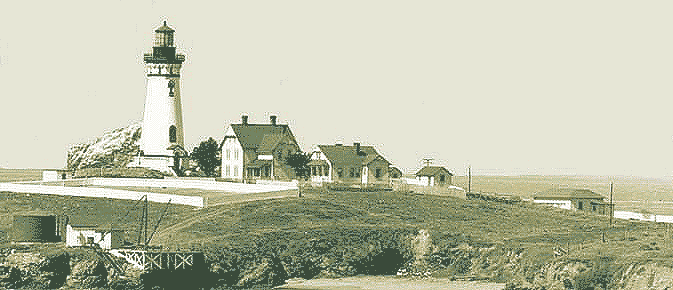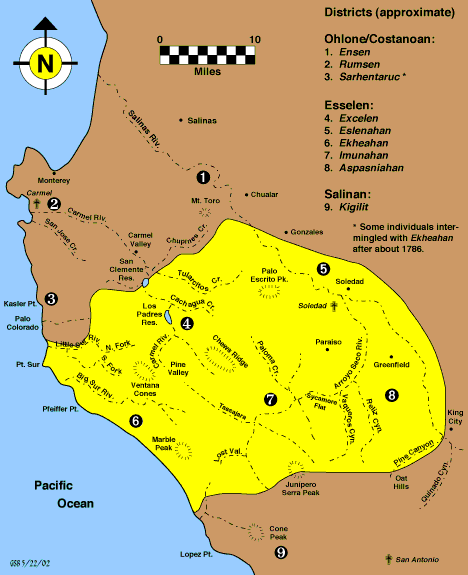
http://www.bigsurcalifornia.org/piedras.html
BIG SUR NATIVE AMERICAN HISTORY
Three Native American tribes were the first people to inhabit the area now known as Big Sur: the Ohlone, Esselen, and Salinan. Archaeological evidence shows that they lived in Big Sur for thousands of years, leading a nomadic, hunter-gatherer existence. Few traces of their material culture have survived. Their arrow heads were made of obsidian, which indicates trading links with tribes hundreds of miles away, since the nearest sources of obsidian are in the Sierra Nevada mountains and the northern California Coast Ranges. Large exposed rocks hollowed out into bowl shapes that were used to grind acorns into flour, can still be found at sites throughout Big Sur today.History of the Esselen Indians
The Esselen are often cited as the first California group to become culturally extinct;1840s a  |
There were five Esselen districts: Excelen, Eslenahan, Imunahan, Ekheahan, and Aspasniahan (see map). Each of these districts occupied a fairly specific territory with generally-recognized boundaries, and most likely had a reasonably stable resident population. Within each district there were a number of villages which were sequentially occupied on a seasonal basis depending on the availability of resources such as food, water, shelter, and firewood. Of these five districts, the boundaries of the Excelen district are probably the best known. The least known boundaries are in the mountainous areas between Excelen, Imunahan, and Ekheahan.Population- It is estimated the Esselen population was approximately 550-1000.
|
 |
The Esalen Institute
Esalen Institute was founded in 1962 by Michael Murphy and Richard Price as an educational center for the exploration of unrealized human capacities. It soon became known for its blend of East/West philosophies, focusing on stimulating creativity and new ways of thinking with inspiration.
The Esalen Institue is widely known for its experiential workshops, including many leading philosophers, psychologists, artists, and religious thinkers, along with its breathtaking grounds blessed with natural hot springs. Once home to a Native American tribe known as the Esselen, Esalen is situated on some 200 acres of spectacular Big Sur coastline with the Santa Lucia Mountains rising sharply behind. http://www.esalenctr.org/display/aboutmenu.cfm
Esalen Natural Hot Springs

Big Sur History-Two Mexican land grants were awarded in the 1830's, which included most of the area north of the Big Sur Valley, neither grantee settled on the land. It was little more than a century ago when the first permanent settlers arrived in Big Sur. In the following decades other hardy persons followed and staked out their homesteads.The landmarks bear the names of many of those early settlers - Mt. Manuel, Pfeiffer Ridge, Post Summit, Cooper Point, Dani Ridge, Partington Cove and others. Some of their descendants still live in Big Sur.
At the turn of the century Big Sur sustained a larger population than it does today. A vigorous redwood lumbering industry provided livelihoods for many. The Old Coast Trail, which had been the only link between homesteads, was still little more than a wagon trail. Steamers transported heavy goods and supplies and harbored at Notley's Landing, Partington Cove, and the mouth of the Little Sur River.
Navigation was treacherous, and in 1889, the Point Sur Lighthouse Station began sending its powerful beam to protect ships from the hazards of the coastline. In 1937, the present highway was completed after eighteen years of construction at a considerable expense even with the aid from convict labor and The New Deal. Electricity did not arrive in Big Sur until the early 1950's, and it still does not extend the length of the coast or into the more remote mountainous areas. The new highway construction allowed easy access to other regions in California such as Carmel and Monterey. Furthermore, Hwy 1 dramatically changed the local economy and bridged the gap between the wilderness of Big Sur and the world. Ranches quickly gave way to new tourist venues, and vacation homes for they wealthy. Thankfully, the residents of Big Sur fought to preserve the unsurpassed beauty of the land, and The Monterey County government won the 1962 court case, forbidding billboards and other visual distractions on Hwy 1.
Construction of Bixby Bridge, Highway 1
http://www.bigsurcoastproperties.com/history

HWY 1 TODAY; Known as California's first Scenic Highway due to its unsurpased natural beauty and scenic variety which provides the ideal driving experience.

http://photography.nationalgeographic.com/photography/enlarge/coastal-highway-1_pod_image.html



No comments:
Post a Comment